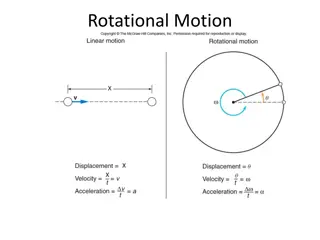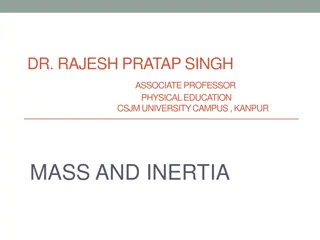Angular Mechanics - Angular Momentum Concepts and Examples
Understanding angular momentum in mechanics involves reviewing linear and angular quantities, comparing angular to linear formulas, and exploring examples of angular momentum and conservation principles. The content covers key factors like angular quantities, torque, and moment of inertia, along wit
3 views • 23 slides
CBAM: a perspective on emissions and global warming
Key considerations for Carbon Border Adjustment Mechanism (CBAM) and carbon pricing are discussed, emphasizing the complexity and inertia of transitioning to a low-emission economy, the need for durable emission reduction solutions, and the impact of non-optimal temperatures on global mortality rate
0 views • 7 slides
Understanding Mass and Inertia in Physics
Mass and inertia are fundamental concepts in physics. Mass is the amount of material in an object, determining its inertia - the resistance to change in motion. Objects with greater mass require more force to change their state of motion. Mass should not be confused with volume or weight, as they ar
0 views • 21 slides
Physical Science Unit 1 Test Review Game
This test review game covers various topics in physical science including concepts like floating and sinking, forces, work, inertia, acceleration, and more. It presents multiple-choice questions with explanations related to lifeguard tests, object forces, average force calculations, work calculation
1 views • 71 slides
Understanding Newton's First Law of Inertia
Newton's first law of inertia states that objects remain at rest or in uniform motion unless acted upon by an external force. This law, also known as the law of inertia, explains how objects tend to maintain their current state of motion unless influenced by an external force. Objects at rest stay a
0 views • 14 slides
Understanding Rotational Motion in Physics
Exploring rotational motion concepts in physics, including the relationship between linear and rotational speed on rotating objects like merry-go-rounds and Ferris wheels. Learn about tangential speed, angular speed, and the principle of rotational inertia that explains why objects tend to keep rota
3 views • 29 slides
Understanding Inertia and Motion in the Moving Earth
Inertia and motion in a moving Earth debunk the argument against Earth's movement using examples of birds catching worms on trees and flipping coins in moving vehicles. Objects on Earth move with Earth's motion, showcasing the principle of inertia in action.
2 views • 7 slides
Understanding Newton's Laws of Motion
Sir Isaac Newton's three laws of motion revolutionized our understanding of the physical world. From the law of inertia to the principles of action and reaction, these laws govern how objects move and interact in our everyday lives. By grasping these fundamental concepts, we can better comprehend th
0 views • 14 slides
Understanding Non-Dimensional Numbers in Fluid Mechanics
Non-dimensional numbers play a crucial role in understanding fluid motion. This includes Reynolds Number for inertia and viscous forces, Froude Number for gravity effects, Cauchy Number for compressible flows, and Mach Number for elasticity forces. These numbers help in analyzing pipe friction, flow
1 views • 10 slides
Classical Mechanics at Neotech Institute of Applied Science and Research, Virod
Delve into the world of Classical Mechanics in B.Sc Semester-V at Neotech Institute of Applied Science and Research, located in Virod, Vadodara. Explore topics such as motion of rigid bodies, angular momentum, Euler's theorem, inertia tensor, and Euler's equations of motion through a comprehensive s
0 views • 27 slides
Quantum Mechanics of Hydrogen Molecule Rotations
Dive into the intriguing world of molecular rotations in hydrogen molecules, exploring topics such as rotational heat capacity, moment of inertia, nuclear spin isomers, and wave number calculations. Understand the implications of particle interactions, distinguishable vs. indistinguishable particles
0 views • 23 slides
Understanding Concepts in Machine Element Dynamics
This unit covers the concepts of D'Alembert principle, precession, gyroscopic couple, inertia force, torque, and dynamic forces associated with accelerating masses in machine elements. Students will learn how these principles affect the equilibrium and behavior of rigid bodies in rotational motion.
1 views • 8 slides
Engineering Dynamics Principles and Problem Solving
Understanding the laws of motion and their application in dynamics is crucial in engineering. This content explains the concepts of force, acceleration, and inertia through practical examples such as projectile motion and frictional forces on a baggage truck. It also demonstrates how to calculate ma
0 views • 10 slides
Geometrical and Kinetic Similarities: Understanding the Science of Equivalence
Explore the connection between entities in physics, such as inertia, pressure, and advance coefficients, and the Reynolds and Froude numbers. Learn about the principles of similarity in practice and how different characteristics are interrelated across various scientific fields.
0 views • 64 slides
Introduction to Kinematics and Dynamics of Machines in Mechanical Engineering
Theory of Mechanics delves into motion, time, and forces, with Kinematics focusing on motion analysis without considering external forces. Kinetics, a branch of Theory of Machines, deals with inertia forces resulting from mass and motion. Dynamics combines Kinematics and Kinetics to study motion and
0 views • 14 slides
Structural Engineering Solutions: Moments, Stresses, and Centroids
An in-depth analysis of structural engineering problems involving centroids, moments of inertia, maximum stresses, and curvature calculations. Solutions are provided for scenarios such as the application of couples to machine parts and wooden beams, determining maximum tensile and compressive stress
0 views • 12 slides
Understanding Retention of Fetal Membranes in Veterinary Obstetrics
Retention of fetal membranes, a common issue during the third stage of labor, has significant consequences for animals, especially cattle. Causes include insufficient expulsive efforts and placental issues. The incidence ranges from 6.8% to 50%, often associated with dystocia and twin births. Factor
0 views • 25 slides
Understanding Newton's Third Law of Motion
Explore the concept of Newton's Third Law of Motion, which states that for every action there is an equal and opposite reaction. Discover examples illustrating this law in action and learn about inertia, unbalanced forces, and the relationship between force, mass, and acceleration according to Newto
0 views • 7 slides
Understanding Newton's Laws of Motion and Law of Universal Gravitation
Isaac Newton, a giant in scientific history, revolutionized physics with his three laws of motion and law of universal gravitation. His laws of inertia, force, and action and reaction explain the behavior of objects in motion, while the law of gravitation describes the force that governs celestial b
3 views • 10 slides
Understanding Rotational Motion in Physics
Exploring rotational motion in physics involves understanding angular velocity, torque, moment of inertia, and rotational kinetic energy. This comprehensive guide covers concepts such as the conversion between degrees and radians, angular variables, Newton's second law for rotating bodies, and momen
0 views • 18 slides
Understanding Rotational Motion in Chapter 10
Exploring the concepts of rotational motion in a rigid object, focusing on angular displacement, velocity, acceleration, torque, and moment of inertia. Key topics include angular quantities, relationships between linear and angular motion, and applications in calculating rotational parameters. Pract
0 views • 29 slides
Understanding Newton's Laws of Motion
Explore Newton's Laws of Motion including the concepts of force, inertia, acceleration, action and reaction forces, and the role of mass in determining motion. Newton's First Law states that objects at rest remain at rest unless acted upon by an unbalanced force. Newton's Second Law relates accelera
0 views • 16 slides
Physics Midterm 1 Review Guide
Overview of important topics for Physics Midterm 1 including Newton's laws, linear motion, momentum, energy, and rotation. Provides key concepts to review, resources for studying, and example questions. Includes explanations on topics like inertia, forces, acceleration, energy conservation, and more
13 views • 90 slides
Understanding Newton's Laws of Motion
Explore Sir Isaac Newton's foundational principles of motion through engaging visuals and real-world examples. Discover how inertia, force, and acceleration shape the dynamics of objects in motion, as explained by Newton's First and Second Laws. Delve into the concept of inertia and the relationship
2 views • 13 slides
Understanding Small Gasoline Engine Performance
This chapter explores the intricacies of measuring and optimizing internal combustion engine performance, focusing on calculating functional horsepower through various formulas and measurements. It delves into the combustion process in a small gasoline engine, detailing how the air/fuel mixture igni
0 views • 66 slides
Understanding Gravity and Inertia: Key Concepts in Motion
Exploring the principles of inertia and gravity, this content delves into how objects resist changes in motion and the force that attracts objects towards each other. From Newton's Law of Gravity to the dynamics of free fall and weight, learn how these fundamental concepts shape our understanding of
0 views • 21 slides
Newton's First Law of Motion: Inertia and Forces
Understanding the concept of inertia in motion, the role of forces in maintaining or changing motion, and analyzing net forces applied to objects. Also explores scenarios where forces are balanced or unbalanced, affecting the motion of objects.
0 views • 12 slides
Understanding Rotational Inertia and Conservation of Momentum
Rotational inertia symbolized as I is crucial in quantifying the torque needed for rotation, depending on mass distribution. Torque, rotational inertia, and mass influence an object's spinning motion, affecting stability and speed. Exploring why wheels keep spinning, ice skaters rotate faster when a
0 views • 23 slides
Understanding Newton's Laws of Motion: Inertia, Forces, and Acceleration
Delve into the fundamentals of Newton's first and second laws of motion, exploring concepts such as inertia, the relationship between forces and acceleration, and the procedure for solving force problems. Discover how objects behave when left to themselves, and grasp the significance of forces in ch
0 views • 21 slides
Understanding Rotational Inertia and Torque in Physics
Rotational inertia symbolizes how difficult it is to change the rotation of an object. It depends on mass distribution from the axis, shape, and mass. Torque needed to start rotation is proportional to rotational inertia. Smaller rotational inertia leads to faster rotational acceleration. Examples a
0 views • 23 slides
Understanding Mass and Inertia in Physics
Understanding the concepts of mass and inertia in physics is essential for comprehending the behavior of objects in motion. Mass is the measure of the quantity of inertia of an object, affecting its resistance to changes in motion. In translational cases, inertia is termed as mass, measured in kilog
0 views • 8 slides
Understanding Moments of Inertia in Structural Mechanics
Moments of inertia of an area play a crucial role in determining the strength and stability of structural members and mechanical elements. This includes concepts such as area moment of inertia, parallel-axis theorem, and radius of gyration. The integration process, positive nature, and units of mome
0 views • 5 slides
Understanding Moment of Inertia and its Importance in Mechanics
Moment of Inertia (MoI) is a crucial concept in mechanics, representing a body's resistance to rotation. It depends on the shape of the object and influences the torque required for rotation. This property plays a significant role in structural mechanics and stress analysis, contributing to understa
0 views • 14 slides
Understanding Power System Inertia in Inverter-Dominated Networks
This study explores the impact of high levels of instantaneous inverter-based renewable energy penetration on power system inertia. It delves into fundamental concepts of energy balance, frequency control, load/frequency characteristics, and the importance of system inertia in maintaining grid stabi
0 views • 20 slides
Moment of Inertia Calculations in Engineering Mechanics - Problems and Solutions
The content covers problems related to calculating moments of inertia in engineering mechanics, specifically focusing on triangular areas, shaded areas, and circles. Detailed step-by-step solutions are provided for each problem, including determining moments of inertia about different axes and findi
0 views • 11 slides
Understanding Area Moment of Inertia and Centroidal Axis in Mechanics
Explore the concept of area moment of inertia and centroidal axis in mechanics through detailed explanations and visual representations. Learn how to determine moment of inertia, locate the centroid, and understand the principles behind mass moment of inertia. Dive into the calculation methods and p
0 views • 14 slides
Understanding Rotational Kinetic Energy and Moment of Inertia
Rotational kinetic energy arises from the motion of mass in a rotating object, while moment of inertia quantifies an object's resistance to rotational motion. This concept is crucial for analyzing the energy and stability of rotating systems. The content explains the calculation of kinetic energy fo
0 views • 7 slides
Optimus Prime's Transformation Challenge: Angular Momentum and Moment of Inertia Exploration
Dr. Mark Huntress, a Chemistry and Physics professor, devises a transformative assignment on rotation. As Optimus Prime aims to rotate as fast as possible with minimal external forces, students explore whether he should transform into a disk, ring, or solid sphere. Through a four-part exploration in
0 views • 16 slides
Understanding Rotational Dynamics in Physics
General announcements for a physics class covering topics on rigid bodies, torque, moment of inertia, and rotational Newton's second law. Learn about the importance of moment of inertia, calculating rotational inertia, and the application of Rotational N2L in problem-solving exercises. Explore the r
0 views • 21 slides
Experimental Determination of Moment of Inertia in Rotational Dynamics Lab
In this university lab experiment, students apply known torques to various objects to measure angular accelerations and determine their moments of inertia. The setup involves rotating discs and rods with masses, using a rotational sensor for data collection. Important steps include measuring diamete
0 views • 12 slides







































